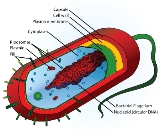
Prokaryote
Overview
The prokaryotes are a group of organism
s that lack a cell nucleus
(= karyon), or any other membrane
-bound organelle
s. The organisms that have a cell nucleus are called eukaryote
s. Most prokaryotes are unicellular, but a few such as myxobacteria
have multicellular
stages in their life cycles
. The word prokaryote comes from the Greek
πρό- (pro-) "before" + καρυόν (karyon) "nut
or kernel
". Prokaryotes do not have a nucleus, mitochondria, or any other membrane-bound organelles.
Organism
In biology, an organism is any contiguous living system . In at least some form, all organisms are capable of response to stimuli, reproduction, growth and development, and maintenance of homoeostasis as a stable whole.An organism may either be unicellular or, as in the case of humans, comprise...
s that lack a cell nucleus
Cell nucleus
In cell biology, the nucleus is a membrane-enclosed organelle found in eukaryotic cells. It contains most of the cell's genetic material, organized as multiple long linear DNA molecules in complex with a large variety of proteins, such as histones, to form chromosomes. The genes within these...
(= karyon), or any other membrane
Cell membrane
The cell membrane or plasma membrane is a biological membrane that separates the interior of all cells from the outside environment. The cell membrane is selectively permeable to ions and organic molecules and controls the movement of substances in and out of cells. It basically protects the cell...
-bound organelle
Organelle
In cell biology, an organelle is a specialized subunit within a cell that has a specific function, and is usually separately enclosed within its own lipid bilayer....
s. The organisms that have a cell nucleus are called eukaryote
Eukaryote
A eukaryote is an organism whose cells contain complex structures enclosed within membranes. Eukaryotes may more formally be referred to as the taxon Eukarya or Eukaryota. The defining membrane-bound structure that sets eukaryotic cells apart from prokaryotic cells is the nucleus, or nuclear...
s. Most prokaryotes are unicellular, but a few such as myxobacteria
Myxobacteria
The myxobacteria are a group of bacteria that predominantly live in the soil. The myxobacteria have very large genomes, relative to other bacteria, e.g. 9-10 million nucleotides. Sorangium cellulosum has the largest known bacterial genome, at 13.0 million nucleotides...
have multicellular
Multicellular organism
Multicellular organisms are organisms that consist of more than one cell, in contrast to single-celled organisms. Most life that can be seen with the the naked eye is multicellular, as are all animals and land plants.-Evolutionary history:Multicellularity has evolved independently dozens of times...
stages in their life cycles
Biological life cycle
A life cycle is a period involving all different generations of a species succeeding each other through means of reproduction, whether through asexual reproduction or sexual reproduction...
. The word prokaryote comes from the Greek
Greek language
Greek is an independent branch of the Indo-European family of languages. Native to the southern Balkans, it has the longest documented history of any Indo-European language, spanning 34 centuries of written records. Its writing system has been the Greek alphabet for the majority of its history;...
πρό- (pro-) "before" + καρυόν (karyon) "nut
Nut (fruit)
A nut is a hard-shelled fruit of some plants having an indehiscent seed. While a wide variety of dried seeds and fruits are called nuts in English, only a certain number of them are considered by biologists to be true nuts...
or kernel
Seed
A seed is a small embryonic plant enclosed in a covering called the seed coat, usually with some stored food. It is the product of the ripened ovule of gymnosperm and angiosperm plants which occurs after fertilization and some growth within the mother plant...
". Prokaryotes do not have a nucleus, mitochondria, or any other membrane-bound organelles.

